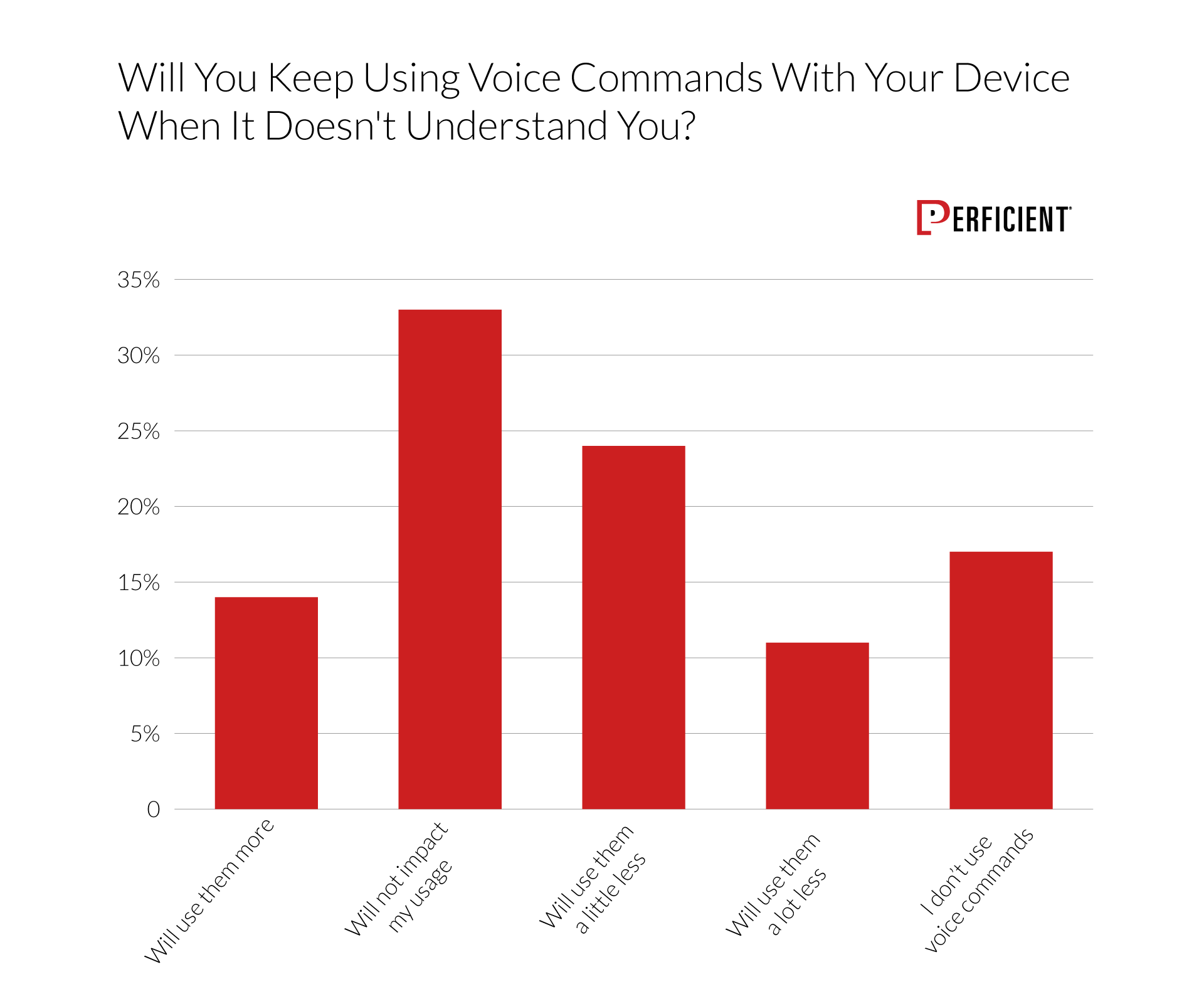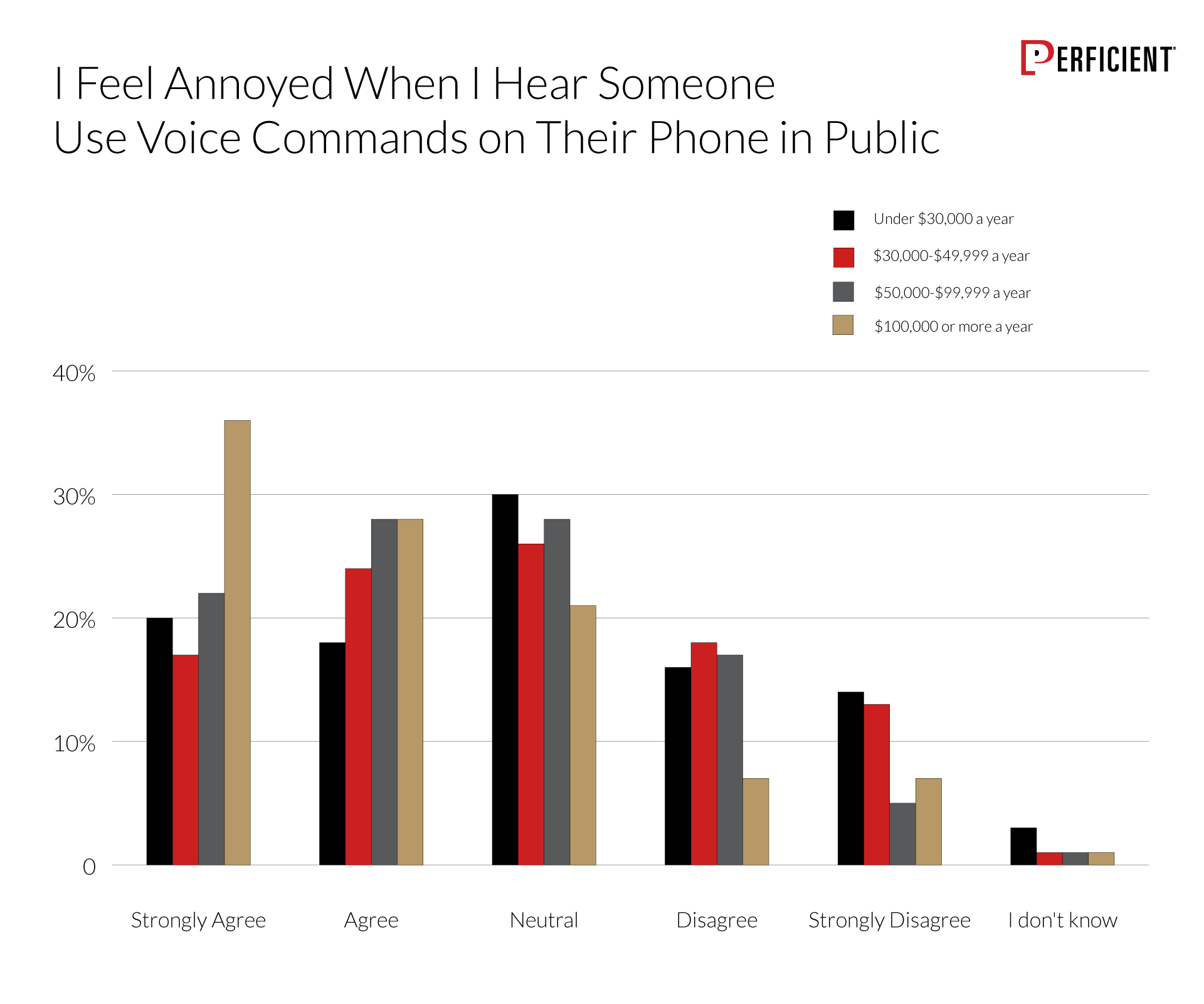Mobile Voice Usage Trends in 2020 / Perficient

This first section goes into detail on how people use voice commands, or other methods, to do what they want with their devices. Our first question asked users what methods they use to look up information on their smartphones.
Using voice came in fourth place, behind typing into search engine apps (75%), opening up a browser (72%), and typing into the search window on their phone (63%). Nonetheless, more than half of the respondents (55%) included using voice searches as one of their top three answers.
Our next question asked how often users make use of smart speakers.
Fewer than 20% of respondents used a smart speaker to search for information more than five times per week. “Never” and “less than twice per week” made up 56% of all responses. Since this indicated that voice usage to replace traditional methods for searching for information has a long way to go, we also wanted to also explore why that may be.
In our next question, we asked users if they get frustrated when their device doesn’t recognize what they’ve said.

59% of those polled agreed or strongly agreed that this was frustrating. We then asked whether or not the device not understanding them impacted how they used the device.

Nearly 36% of respondents said they would use the device less (and 16.9% said that they don’t use voice commands). As a next step, we explored whether getting an incorrect answer would impact their level of usage.
More than 41% replied that incorrect answers will lower their usage. From here, our questions shifted direction a bit, to explore other aspects of how users leverage voice commands with their devices.
The first question in this set explored what devices they use voice commands with the most.
Mobile phones are the most common devices for using voice commands by a wide margin (nearly 40% more than usage with smart speakers). Next, we asked users what would make them likely to use voice commands more.
The three most popular choices were, respectively: My device better understanding what I’m asking (1,912 votes); My device giving a more accurate answer to the question I ask (1,231 votes); My device being able to handle multi-step interactions (1,164 votes). These all relate to the device’s capabilities in understanding what you want and/or providing you what you want. These were followed by the ability to make purchases using only voice commands (768 votes).
As in prior years, we asked questions about using voice commands while driving.
Only 9% of respondents said that they did so more than five times per day, with 42% responding rarely or never.
Why are people reluctant to use voice commands while driving? We asked our panel, “Do you think using voice commands while driving is distracting?” The responses were as follows:
The split here was tight, with 51% responding yes and 49% saying no. Next up, we asked participants how often they used voice commands with devices other than their phones.
Forty-five percent of respondents use voice commands at least daily, which is higher than we expected. However, this is likely driven by Smart Speaker users. Note that this question was regarding voice commands, not voice searches (so “Alexa set a timer” would be counted here).
We then asked, “What is your preferred method of sending a text message?”
You can see that typing by hand dominates this question, with 75% of respondents choosing this answer, while using voice to enter in your text is used by 19% of people. Sending a text as a recorded voice message is only preferred by 5% of users (prior years have ranged from 4% to 7%).
Next up, we asked people about the quality of speech recognition, with the following question: “How well do your built-in personal assistants on your phone, such as Google Assistant, Cortana, and Siri, understand you?” Here is what we got:
The responses “Very Well” and “Well” came in at 48% combined, and when you include “Not Bad,” the combined total goes up to 75%.
One reason people may hold back from using voice more is their reluctance to bother others. We decided to explore just how real that fear is and asked, “Do you agree with these below statements? I feel annoyed when I hear someone use voice commands on their phone in a public setting.” Here are the results:
Among respondents, 49% chose “Agree” or “Strongly Agree” and only 23% selected “Disagree” or “Strongly Disagree” so a stigma still remains. This is in spite of the data we will present later in this report that suggests people are becoming more comfortable using voice with their devices in front of others.
This question skews toward higher incomes in a big way, with 64% of those who make $100K+ indicating they get annoyed, and 50% of those who make $50 to $99K responding the same. You can see the clear trend in this chart:

For the last question in this section of our study, we asked: “What Features Would You Like Your Personal Assistant to Offer in the Future?” Here are the results:
The top response was “more app integration” at 32%, with “support for other languages” coming in at 27%.
Source link



